November itinerary in Japan Day 4 (Fukuoka Day 2)
(Thursday, November 18)
Table of contents
1. Munakata Taisha “Hetsu-miya”
2. Munakata Taisha “Takamiya Saijo (Festival place)”
3. Munakata Taisha “Shinpokan”
4. Munakata Taisha “Okitsu-miya Yohaisho” (Oshima)
5. Munakata Taisha “Nakatsu-miya” (Oshima)
1. Munakata Taisha “Hetsu-miya”
On the morning of the 4th day, I went to Munakata Taisha “Hetsu-miya” from Hakata Station. The public transportation I used is as follows.
Depart Hakata Station at 8:07, Kagoshima Line Rapid train bound for Moji Port, arrive at Togo Station at 8:36, fare Yen 570
Depart Togo Station at 8:56, line 1 Nishitetsu bus bound for Konominato Wharf, arrives at Munakata Taisha at 9:05 , fare Yen 240
Munakata Taisha “Hetsu-miya” is a 1-minute walk from the bus stop of Munakata Taisha.
Munakata Taisha is one of the oldest shrines in Japan, which is also mentioned in “Nihon Shoki” and “Sequel Nihon Shoki”. It is the head shrine of more than 7,000 shrines in Japan that enshrine the Three Goddesses of Munakata, Itsukushima Shrine.
Munakata was the first international port in Japan. As a port to the Korean Peninsula and China, it played the role of diplomacy, commerce, and national defense in ancient Japan for about 500 years from the latter half of the 4th century to the end of the 9th century. For these reasons, in 2017, Munakata Taisha Shrine was registered as a World Heritage Site as “Sacred Island of Okinoshima and Associated Sites in the Munakata Region” .
In addition, the main shrine and worship hall of Munakata Taisha “Hetsu-miya” are designated as national important cultural properties. The main shrine was built in 1578 and the worship hall was built in 1590.

Unlike many other shrines, the hall of worship at Munakata Shrine “Hetsu-miya” cannot be seen from the front because a temporary hut was built. This is very disappointing.
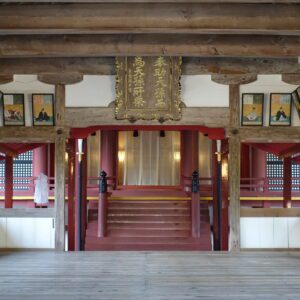
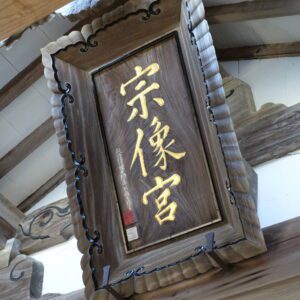
There are 22 small shrines around the main shrine, and 121 gods are enshrined. Munakata Taisha was one of the eight shrines nationwide designated as “Shingun”. “Shingun” is a kind of shrine territory, and the income from “Shingun” was used for repair and ritual expenses of the shrine.This group of end shrines is dedicated to the Munakata Shrine “Hetsu-miya”, which is the only “Shingun” in Kyushu. The existence of small shrines lined up in a row is a masterpiece and shows the high shrine rank of Munakata Taisha.
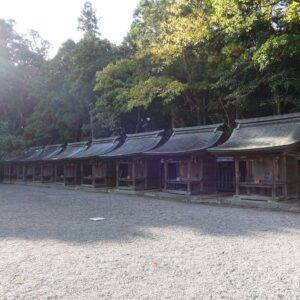
The second shrine (Okitsu-miya branch) and the third shrine (Nakatsu-miya branch) are located a short walk from the main shrine and worship hall of Munakata Shrine. For those who cannot go to Okitsu-miya (Okinoshima) and Nakatsu-miya (Oshima), which are far away, it is a very kind branch company that allows you to visit Okitsu-miya and Nakatsu-miya even around Hetsu-miya. The second and third shrines have the same shape.

2. Munakata Taisha “Takamiya Saijo (Festival place)”
There is “Takamiya Saijo” about 3 minutes on foot from the 2nd and 3rd shrines. “Takamiya Saijo” is an ancient festival grounds that is said to be the land of descent of Ichikishima-hime God. There are only a few places in Japan where ancient festivals based on nature worship remain. It is considered to be one of the most sacred places in the precincts of Munakata Taisha.
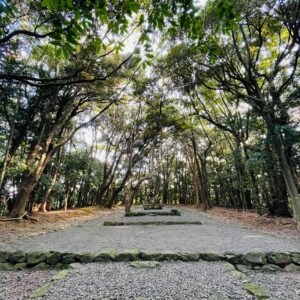
At the time of my visit, there was no one else at the “Takamiya Saijo”. Therefore, I was able to enjoy the solemn atmosphere of the ancient festival grounds. The place I was most impressed with at Munakata Taisha was the “Takamiya Saijo”. It was a lot of fun to imagine ancient people in places where they were afraid of nature and prayed for their health and safety.
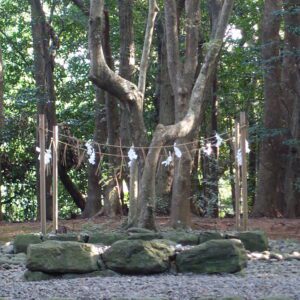
Every year on October 3rd (the last day of the Autumn Festival), the Kannabi Festival (the eternal dance of the night kagura) is performed at the “Takamiya Saijo”. Yukyu Mai (the eternal dance) is an event that was revived in 2005 for the first time in 630 years. The Autumn Festival on October 1st begins with the majestic “Miare Festival”, a magnificent maritime god that surrounds two Gozabune boats carrying Shintai with hundreds of fishing boats. I would like to revisit Munakata Shrine during the Autumn Festival and see the Miare Festival and the Kannabi Festival.
3. Munakata Taisha “Shinpokan”
The Shinpokan of Munakata Taisha is a collection of 80,000 national treasures of Okinoshima God, as well as important cultural properties that have been handed down to Munakata Taisha. I wrote mainly about national treasures, but almost all of the items on display were national treasures. It was my first experience to see so many national treasures at once, and I was really overwhelmed.
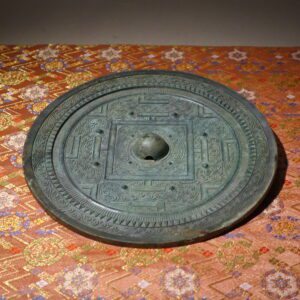
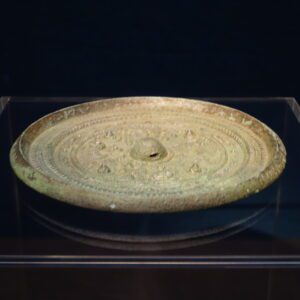
The national treasures that accumulated the high technology of the ancient people were wonderful. All of these great items were allowed to be photographed. Even just visiting the Shinpokan, I thought it was worth visiting Fukuoka Prefecture.
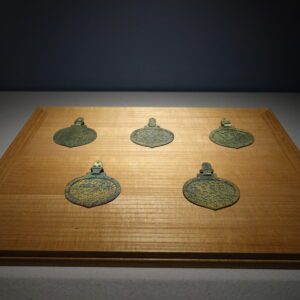

Many shrines and temples all over Japan have treasure halls like Shinpokan. However, many of the items on display at the Treasure Museum are as good as the treasures of the municipalities, and many of them have little academic or artistic value. However, almost all of the items on display at the Shinpokan are national treasures of super-first-class academic and artistic value, and are exceptional treasure museums. By all means, I would like everyone to visit the Shinpokan.
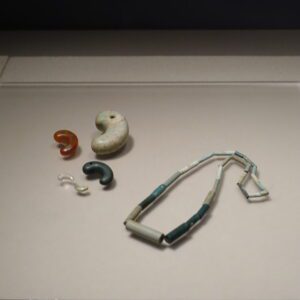
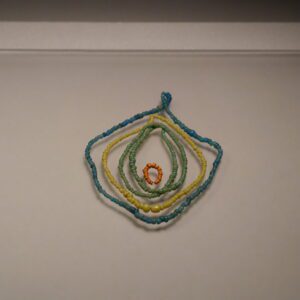
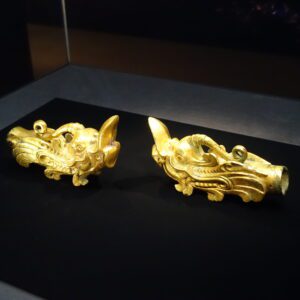
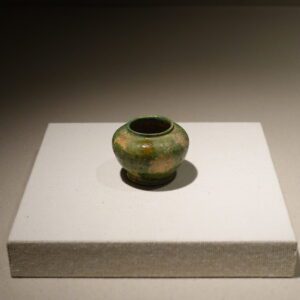
On the 3rd floor of the Shinpokan, the work of artist Naoko Serino’s jute hemp was exhibited. These contemporary arts were also wonderful.

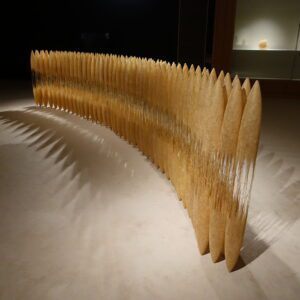
Admission fee: Yen 800 for adults, Yen 500 for high school / university students, Yen 400 for elementary / junior high school students
4. Munakata Taisha “Okitsu-miya Yohaisho” (Oshima)
I took a bus from Munakata Taisha “Hetsu-miya” to Konominato Port and went to Oshima by ship. The name Konominato (God port) is very nice, because we can imagine that God came and went in ancient times at this port. The buses and ships I used are as follows.
Depart Munakata Taisha at 10:20, line 1-2 bound for Koyodai 6-chome, arrive at Konominato Wharf at 10:36, fare Yen 210
Depart Konominato Port at 11:15, passenger ship “Shiokaze”, arrive at Oshima Port 1at 11:30, fare Yen 570
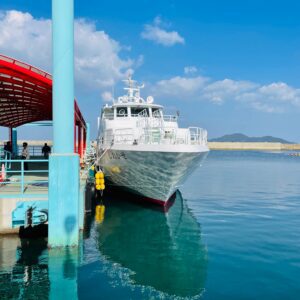
The weather was fine on the day I boarded, and I was able to see a very beautiful view from the ship.
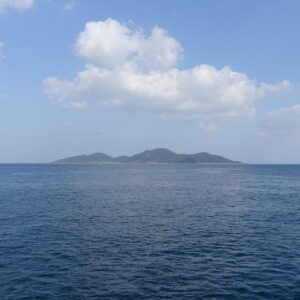
After arriving at Oshima Port, I rented a bicycle with electric assist at the Oshima Tourist Shop / Information Center at the Oshima Ferry Terminal. The fee was yen 800 a day. There is also a sightseeing bus “Miare & Grand Cimar” that goes around Oshima. The one-day pass is Yen 800. They operate 7 services a day every 40 to 70 minutes.
After having lunch, I went to “Okitsu-miya Yohaisho” by bicycle. On the way, there was “Yume no Sayoshima” where a torii stands in front of small island.
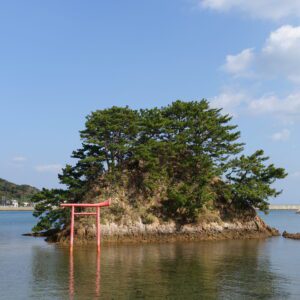
I arrived at “Okitsu-miya Yohaisho” in about 5 minutes by bicycle from “Yume no Sayoshima”. The “Okitsu-miya Yohaisho” was set up on the north side of Oshima to worship Okinoshima, which is prohibited from going to the island.
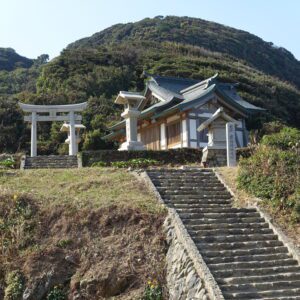

The weather was nice, so the sea around the “Okitsu-miya Yohaisho” was very beautiful.

Next, I went to Mt. Mitake Observatory, which is about 15 minutes by bicycle from “Okitsu-miya Yohaisho”. At the observatory on the summit of Mt. Mitake at an altitude of 224m, I was tired of climbing the slope to the observatory even with an electrically power assisted bicycle.
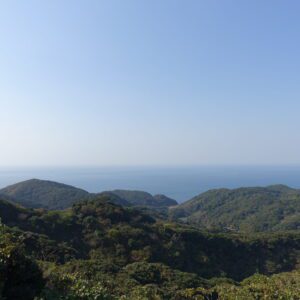
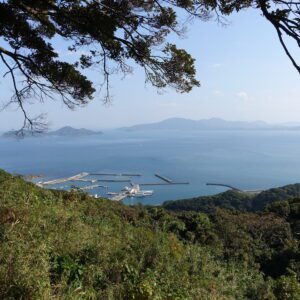
Next to the Mt. Mitake Observatory is the Mitake Shrine. Ancient ritual sites from the 7th to 9th centuries have also been found at this shrine.
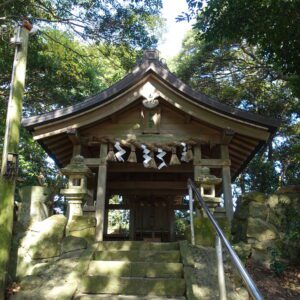
After the Mt. Mitake Observatory, I went to the Windmill Observatory / Canon Ruins, which is about 5 minutes away by bicycle. The canon was built in 1936. The sea seen from the Windmill Observatory / Canon Ruins was also very beautiful. Nearby is the Canadian Camp Oshima Ranch, where horses are kept. In addition, there is a memorial monument to the Russo-Japanese War at the Windmill Observatory / Canon Ruins. A naval battle between Japan and Russia in the Genkai Sea off the coast of Oshima killed nearly 5,000 soldiers.
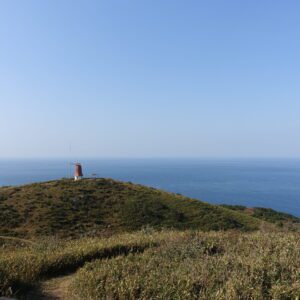
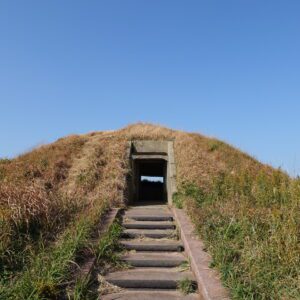
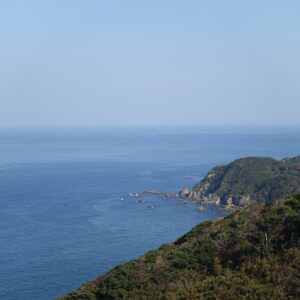
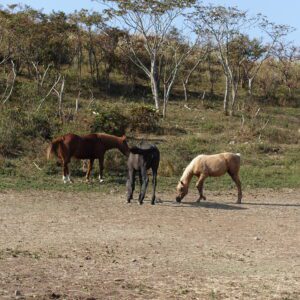
5. Munakata Taisha “Nakatsu-miya” (Oshima)
We stopped at Oshima Lighthouse on the way to Munakata Taisha “Nakatsu-miya” from the Windmill Observatory / Canon Ruins. It is about 5 minutes by bicycle from the Windmill Observatory / Canon Ruins. Oshima Lighthouse is a historic lighthouse that started operation in 1926. The view from the lighthouse was also very beautiful.

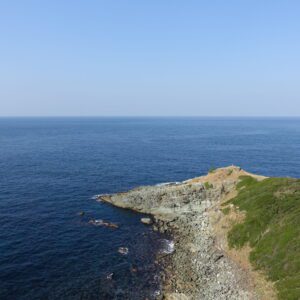
It took about 15 minutes by bicycle from Oshima Lighthouse to Munakata Taisha “Nakatsu-miya”. The main shrine of Nakatsu-miya was built in 1566.
Unlike Hetsu-miya, there is no temporary hut in front of the worship hall of Nakatsu-miya, and you can see it from the front. It is a very nice hall of worship and the main hall.
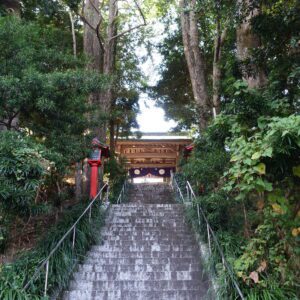
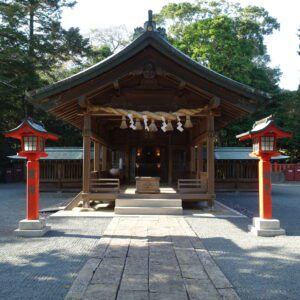
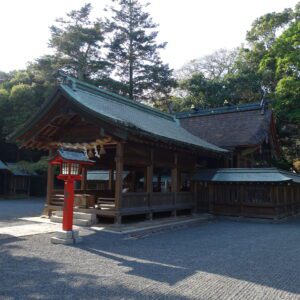
I headed from Nakatsu-miya to Oshima Ferry Terminal, but I had time to set sail, so I went to “Kansu Beach” where “Yume no Sayoshima” is located. “Kansu” is a sandbar that appears at low tide. In the afternoon, I saw a sandbar that I couldn’t see after lunch.
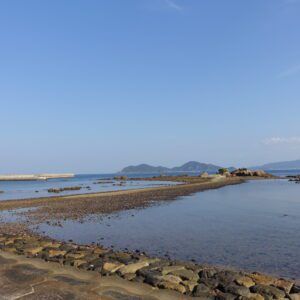
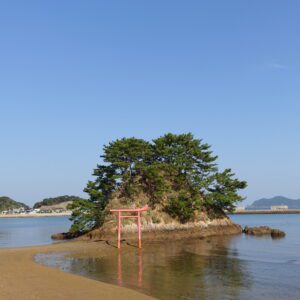
Munakata Shrine “Hetsu-miya” and Oshima were all wonderful, including buildings, ancient festival grounds, national treasures of the Shinpokan, and beautiful scenery of Oshima. I have visited Fukuoka prefecture many times, but my main focus was on sightseeing in Hakata. By visiting Munakata City this time, I was able to discover the new charm of Fukuoka Prefecture.
I went to Konominato Port from Oshima Ferry Terminal and returned to Hakata Station via Togo Station. The public transportation I used is as follows.
Depart Oshima port at 14:40, passenger ship “Shiokaze”, arrive at Konominato Port 14:55, fare Yen 570
Depart Konominato Wharf at 15:07, line1 bound for JR Togo Station, arrive at JR Togo Station at 15:26, fare Yen 370
Depart Togo Station at 15:34, JR Kagoshima Line rapid train bound for Tosu, arrive at Hakata Station at 16:05, fare Yen 570
Note: The departure / arrival times, fares, admission fees, meal fees, etc. of the transportation facilities listed in the text are as of the time of writing the BLOG. They may change in the future, so Please verify yourself when you go on a trip.